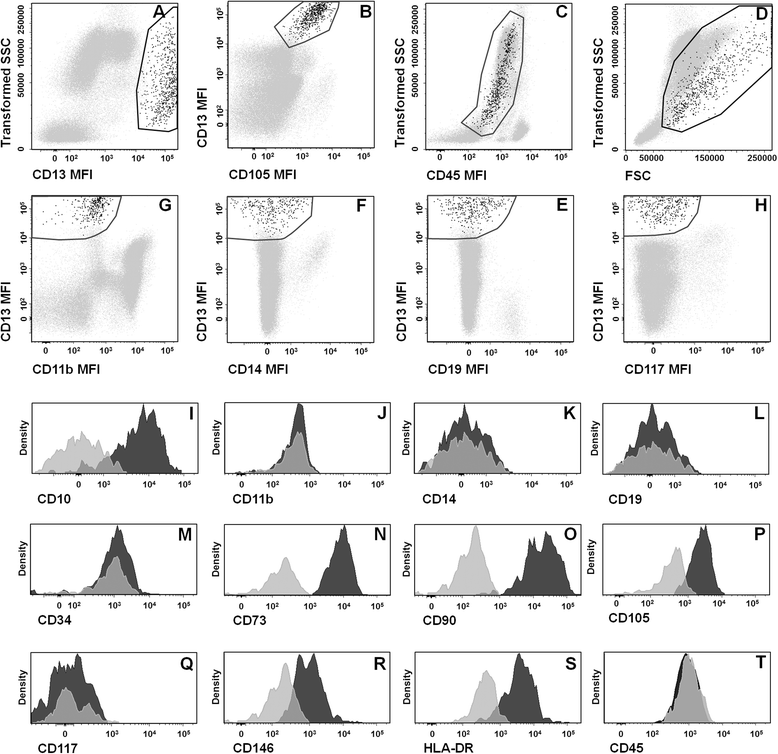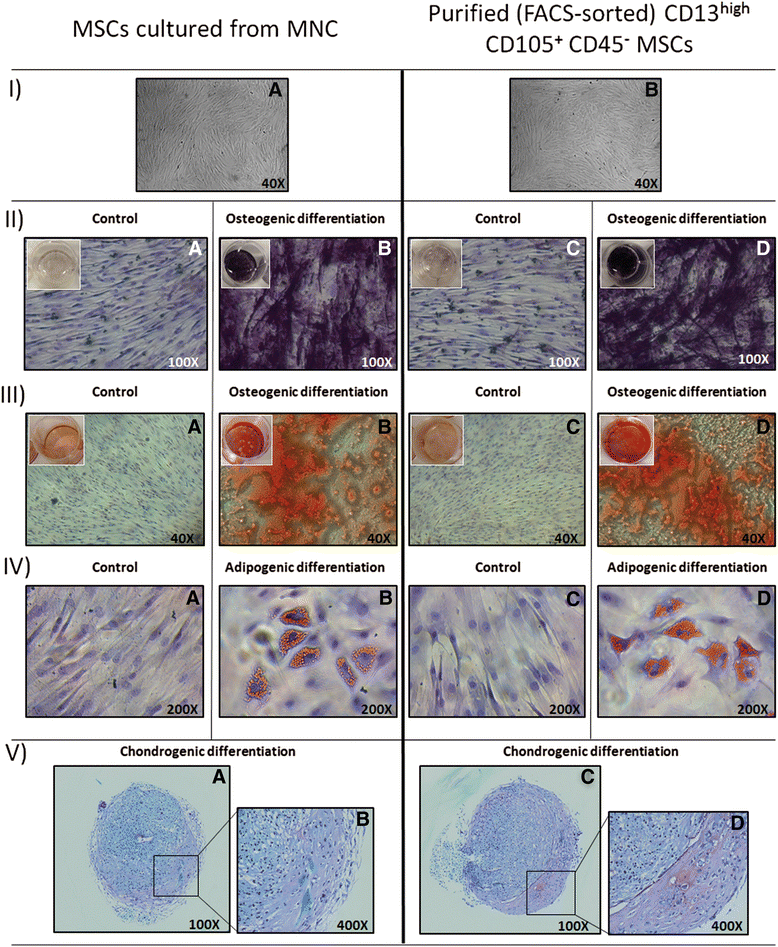Ex vivo identification and characterization of a population of CD13(high) CD105(+) CD45(-) mesenchymal stem cells in human bone marrow
- PMID: 26347461
- PMCID: PMC4562124
- DOI: 10.1186/s13287-015-0152-8
Ex vivo identification and characterization of a population of CD13(high) CD105(+) CD45(-) mesenchymal stem cells in human bone marrow
Abstract
Introduction: Mesenchymal stem cells (MSCs) are multipotent cells capable of self-renewal and multilineage differentiation. Their multipotential capacity and immunomodulatory properties have led to an increasing interest in their biological properties and therapeutic applications. Currently, the definition of MSCs relies on a combination of phenotypic, morphological and functional characteristics which are typically evaluated upon in vitro expansion, a process that may ultimately lead to modulation of the immunophenotypic, functional and/or genetic features of these cells. Therefore, at present there is great interest in providing markers and phenotypes for direct in vivo and ex vivo identification and isolation of MSCs.
Methods: Multiparameter flow cytometry immunophenotypic studies were performed on 65 bone marrow (BM) samples for characterization of CD13(high) CD105(+) CD45(-) cells. Isolation and expansion of these cells was performed in a subset of samples in parallel to the expansion of MSCs from mononuclear cells following currently established procedures. The protein expression profile of these cells was further assessed on (paired) primary and in vitro expanded BM MSCs, and their adipogenic, chondrogenic and osteogenic differentiation potential was also determined.
Results: Our results show that the CD13(high) CD105(+) CD45(-) immunophenotype defines a minor subset of cells that are systematically present ex vivo in normal/reactive BM (n = 65) and that display immunophenotypic features, plastic adherence ability, and osteogenic, adipogenic and chondrogenic differentiation capacities fully compatible with those of MSCs. In addition, we also show that in vitro expansion of these cells modulates their immunophenotypic characteristics, including changes in the expression of markers currently used for the definition of MSCs, such as CD105, CD146 and HLA-DR.
Conclusions: BM MSCs can be identified ex vivo in normal/reactive BM, based on a robust CD13(high) CD105(+) and CD45(-) immunophenotypic profile. Furthermore, in vitro expansion of these cells is associated with significant changes in the immunophenotypic profile of MSCs.
Figures



Similar articles
-
[Proliferation and differentiation characteristics of human bone marrow mesenchymal stem cells during ex-vivo expansion].Xi Bao Yu Fen Zi Mian Yi Xue Za Zhi. 2006 Jan;22(1):7-10. Xi Bao Yu Fen Zi Mian Yi Xue Za Zhi. 2006. PMID: 16388733 Chinese.
-
Isolation of human bone marrow mesenchymal stem cells using different membrane markers: comparison of colony/cloning efficiency, differentiation potential, and molecular profile.Tissue Eng Part C Methods. 2008 Dec;14(4):333-9. doi: 10.1089/ten.tec.2008.0173. Tissue Eng Part C Methods. 2008. PMID: 18800875
-
Differentiation of synovial CD-105(+) human mesenchymal stem cells into chondrocyte-like cells through spheroid formation.J Cell Biochem. 2009 Sep 1;108(1):145-55. doi: 10.1002/jcb.22238. J Cell Biochem. 2009. PMID: 19544399
-
Mesenchymal stem cells and their use in therapy: what has been achieved?Differentiation. 2013 Jan;85(1-2):1-10. doi: 10.1016/j.diff.2012.08.004. Epub 2013 Jan 11. Differentiation. 2013. PMID: 23314286 Review.
-
Mesenchymal stem cells: Cell therapy and regeneration potential.J Tissue Eng Regen Med. 2019 Sep;13(9):1738-1755. doi: 10.1002/term.2914. Epub 2019 Jul 25. J Tissue Eng Regen Med. 2019. PMID: 31216380 Review.
Cited by
-
Effects of single and multiple transplantations of human umbilical cord mesenchymal stem cells on the recovery of ovarian function in the treatment of premature ovarian failure in mice.J Ovarian Res. 2021 Sep 15;14(1):119. doi: 10.1186/s13048-021-00871-4. J Ovarian Res. 2021. PMID: 34526090 Free PMC article.
-
Transcriptional Targets of TWIST1 in Human Mesenchymal Stem/Stromal Cells Mechanistically Link Stem/Progenitor and Paracrine Functions.Stem Cells. 2023 Dec 14;41(12):1185-1200. doi: 10.1093/stmcls/sxad070. Stem Cells. 2023. PMID: 37665974 Free PMC article.
-
Mesenchymal Stromal/Stem Cells in Regenerative Medicine and Tissue Engineering.Stem Cells Int. 2018 Aug 19;2018:8031718. doi: 10.1155/2018/8031718. eCollection 2018. Stem Cells Int. 2018. PMID: 30210552 Free PMC article. Review.
-
Five-Year Outcomes After Implantation of a Scaffold-Free Tissue-Engineered Construct Generated From Autologous Synovial Mesenchymal Stromal Cells for Repair of Knee Chondral Lesions.Orthop J Sports Med. 2023 Aug 8;11(8):23259671231189474. doi: 10.1177/23259671231189474. eCollection 2023 Aug. Orthop J Sports Med. 2023. PMID: 37564952 Free PMC article.
-
Chronic obstructive pulmonary disease and asthma: mesenchymal stem cells and their extracellular vesicles as potential therapeutic tools.Stem Cell Res Ther. 2022 Jun 20;13(1):262. doi: 10.1186/s13287-022-02938-5. Stem Cell Res Ther. 2022. PMID: 35725505 Free PMC article. Review.
References
Publication types
MeSH terms
Substances
LinkOut - more resources
Full Text Sources
Other Literature Sources
Research Materials
Miscellaneous

